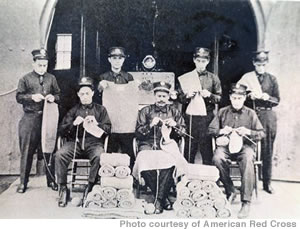Knitting The Fabric Of Hawaii

|
Ninety years ago, Hawaii’s future Territorial Hawaii Gov. George Carter declared: “The Red Cross organization is the channel along which the generosity of our hearts may be carried into action.”
The same is true today.
Founded on seven fundamental principles of humanity, impartiality, neutrality, independence, voluntary service, unity and universality, the Red Cross has stood the test of time.
During WWI, the Red Cross rallied people of all ages and ethnicities into action to assist in the war relief effort. This show of support truly demonstrates that the Red Cross is for all people.
In Hawaii, men, women and children of all ages sewed and knitted surgical dressings, hospital garments, blankets, sweaters, socks, hats and gloves. Yes, even men. In fact, the firemen at the Makiki station became well-known for their knitting. By 1918, more than 280,000 items had been produced by volunteers in Hawaii to be sent to the war front.
Queen Liliuokalani was an ardent supporter of the Red Cross. When a flag she sewed was presented to the territorial governor in 1917, the queen said, “The flag is an expression of my warm and hearty sympathy for the cause of humanity.” The queen’s flag flew over Iolani Palace during the war and is now displayed at the Hawaii Red Cross office, on permanent loan from the state archives. During its first membership drive, the queen herself donated $100 to become a patron member of the Red Cross.
When Pearl Harbor was attacked on Dec. 7, 1941, people in Hawaii again flocked to volunteer for the Red Cross. Canteen Corps prepared and served meals, Motor Corps transported women in labor to the hospital and donors to the blood bank, production workers made surgical dressings, Sewing Corps made clothing and other items, Knitting Corps made sweaters for armed forces, and Home Service assisted with communication between servicemen and their families. At the hospitals, nurse aides tended to the wounded, and volunteers affectionately called “Gray Ladies” because of their uniforms helped with letter-writing, organized recreational opportunities and provided warmth and cheer.
For 90 years, the Red Cross has played a vital role in helping the people of Hawaii recover from every major disaster, including Hurricanes Iniki and Iwa, the Sacred Falls landslide, New Year’s and Manoa floods, Kaloko Dam burst, volcanic eruptions, air crashes and last October’s earthquake.
But just because a disaster does-n’t happen to a lot of people at once doesn’t mean it’s not a disaster for that family who has just lost their home. Everyday disasters happen at least twice a week in Hawaii, and Red Cross volunteers are ready to respond 24 hours a day, 365 days a year.
We also continue to help our neighbors across the nation and around the world. When the South Asia tsunami killed 200,000 people, folks in Hawaii donated $3 million to help the survivors. When Hurricane Katrina struck, $5 million was raised, 34 Hawaii volunteers (including myself) were deployed, and we assisted 70 families who fled to Hawaii from the Gulf Coast. Our local volunteers have helped with everything from 9-11 to Kansas tornadoes and Nor’easter storms, to the California wildfires.
For the past 90 years, the Red Cross has provided vital services to the people of Hawaii. And even though we work side-by-side with firefighters, police, civil defense and the military, we are not a government agency and must rely on the generosity of Hawaii’s people to provide these services to our community.
For information on how you can volunteer or donate to the Red Cross, log onto our website at www.hawaiiredcross.org.
E-mail this story | Print this page | Comments (0) | Archive | RSS Comments (0) |
Most Recent Comment(s):




 Del.icio.us
Del.icio.us








